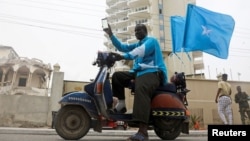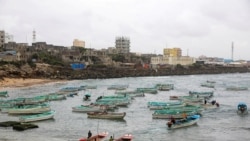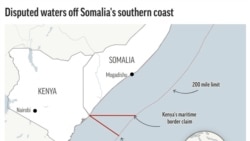Somalia has welcomed the International Court of Justice decision giving it the right to control much of the 100,000 square kilometers of the Indian Ocean following a dispute with its neighbor, Kenya. Somalia called on Kenya to respect the court verdict. Kenya says it will not abide by the court’s decision.
On Tuesday evening, Somali president Mohamed Abdullahi Farmaajo said his country accepts the International Court of Justice verdict.
The Somali leader said that in respecting international laws, the Somali federal government accepts the court ruling in line with international laws and norms. He said Somalis hope Kenya’s government will respect the supremacy of international law and forgo what he described as its “misguided and unlawful pursuits.” He said Somalia hopes Kenya will take the verdict as an opportunity to strengthen the relationship between the two countries and cooperation between their people.
Kenya and Somalia have been involved in a court battle since 2014 over where each country’s border in the Indian Ocean starts and ends.
After a seven-year process, ICJ president Joan Donoghue delivered the much-awaited ruling over the border dispute.
“[The court] decides that the starting-point of the single maritime boundary delimiting the respective maritime areas between the Federal Republic of Somalia and the Republic of Kenya is the intersection of the straight line extending from the final permanent boundary beacon PB 29 at right angles to the general direction of the coast with the low-water line,” said Donoghue.
In a statement issued Tuesday, Kenyan President Uhuru Kenyatta has criticized the court decision and alleged the court has no jurisdiction over the matter.
He said the decision will damage its relations with Somalia.
Kenya argued in court there was an agreed boundary between the two countries but the court said Kenya’s claim was not consistent because it signed a memorandum of understanding acknowledging the matter was in dispute.
The judges unanimously decided there was no agreed borderline between the two countries.
The court awarded Somalia the bulk of the territory while adjusting the border slightly northward.
Nabil Orina, an international law expert, said the adjustment was meant to address Kenya’s security and economic interests.
“The court agreed that there was a need to slightly adjust the equidistant line northwards in order to accommodate Kenya which will be significantly cut off if the line remains like that. So, that’s why the line was again redrawn. So, in this case, then Kenya gained a bit of maritime territory but a bigger chunk of that went to Somalia.” said Orina.
The Hague-based court also rejected Somalia’s demand for compensation for Kenya’s past economic activity in the area.
It remains to be seen how the two East African nations manage the border situation as the region faces pressing issues, including terrorism.








